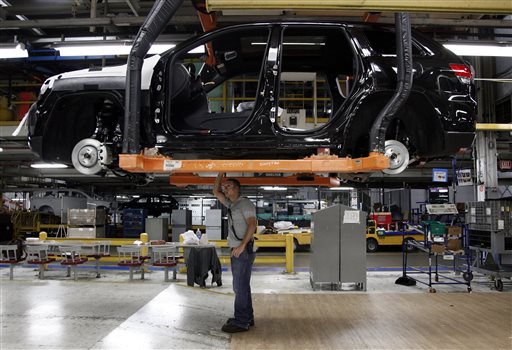WASHINGTON — The U.S. economy grew at a 2.5 percent annual rate from April through June, much faster than previously estimated. The steep revision was largely because U.S. companies exported more goods and imports declined.
The Commerce Department said second-quarter growth was sharply higher than the initial 1.7 percent rate it reported last month. And the growth this spring was more than double the 1.1 percent rate from January through March.
The improvement in the trade deficit helped offset a weaker government spending.
Economists expect growth will stay at an annual rate of around 2.5 percent in the second half of the year, helped by steady job gains and less drag from federal spending cuts. Still, some say higher interest rates might restrain the economy’s expansion in the second half.
Rates could rise even further if the Federal Reserve decides to reduce its $85 billion a month in bond purchases at its September meeting. The Fed will consider the stronger second-quarter growth when making a decision next month. The bond purchases have helped keep long-term borrowing rates low.
Paul Ashworth, chief U.S. economist at Capital Economics, said stronger growth in the second quarter “should give Fed officials more confidence that the recovery is gathering steam as the fiscal drag begins to fade.”
He said the Fed is now more likely to slow the bond purchases in September, although that decision depends heavily on the August employment report. The government will release the employment report next week.
Ashworth forecast that growth in the current July-September quarter was likely to come in around 2.5 percent as well with the potential for even stronger growth in the October-December quarter. But he said the forecast assumes the Obama administration and Congress reach a deal to fund the government before it hits its $16.7 trillion borrowing limit cap in mid-October.
The government’s estimates of economic expansion measure changes in the gross domestic product, the broadest gauge of the economy. GDP measures the output of all goods and services produced in the United States.
The revision was made after the trade deficit narrowed sharply in June — information that wasn’t available to government analysts produced their first estimate for second-quarter growth. The additional information left trade neutral in the second quarter, instead of subtracting 0.8 percentage points from growth.
Government spending shrank an annual rate of 0.9 percent in the second quarter, much worse than the 0.4 percent drop initially estimated. Spending by the federal government shrank at a 1.6 percent annual rate. State and local governments cut at a 0.5 percent rate.
Two key areas of the economy — housing and business investment — remained strong in the revision to second-quarter growth. Housing construction grew at an annual rate of 12.9 percent, the fourth consecutive quarter of double-digit growth. Business investment on structures was revised up to at 16.1 percent rate, although spending on equipment was revised a bit lower.
Consumer spending, which accounts for 70 percent of economic activity, grew by a 1.8 percent rate in the second quarter. That’s unchanged from the initial estimate but down from a 2.3 percent growth rate in the first quarter.
Many economists said a key signal of the economy’s health in the second half of 2013 will come from Friday’s report on consumer spending in July. Consumer spending held up in June. But rising interest rates might have caused it to slow in July.
Long-term rates have risen since Chairman Ben Bernanke said in June that the Federal Reserve could begin trimming its bond purchases later this year if the overall economy and the job market kept improving. Many economists think the Fed will begin slowing its monthly bond purchases to $70 billion or $75 billion. Others think it will delay any pullback in bond buying to await more data on how the economy is faring in the second half of the year.
Copy the Story LinkSend questions/comments to the editors.



Success. Please wait for the page to reload. If the page does not reload within 5 seconds, please refresh the page.
Enter your email and password to access comments.
Hi, to comment on stories you must . This profile is in addition to your subscription and website login.
Already have a commenting profile? .
Invalid username/password.
Please check your email to confirm and complete your registration.
Only subscribers are eligible to post comments. Please subscribe or login first for digital access. Here’s why.
Use the form below to reset your password. When you've submitted your account email, we will send an email with a reset code.